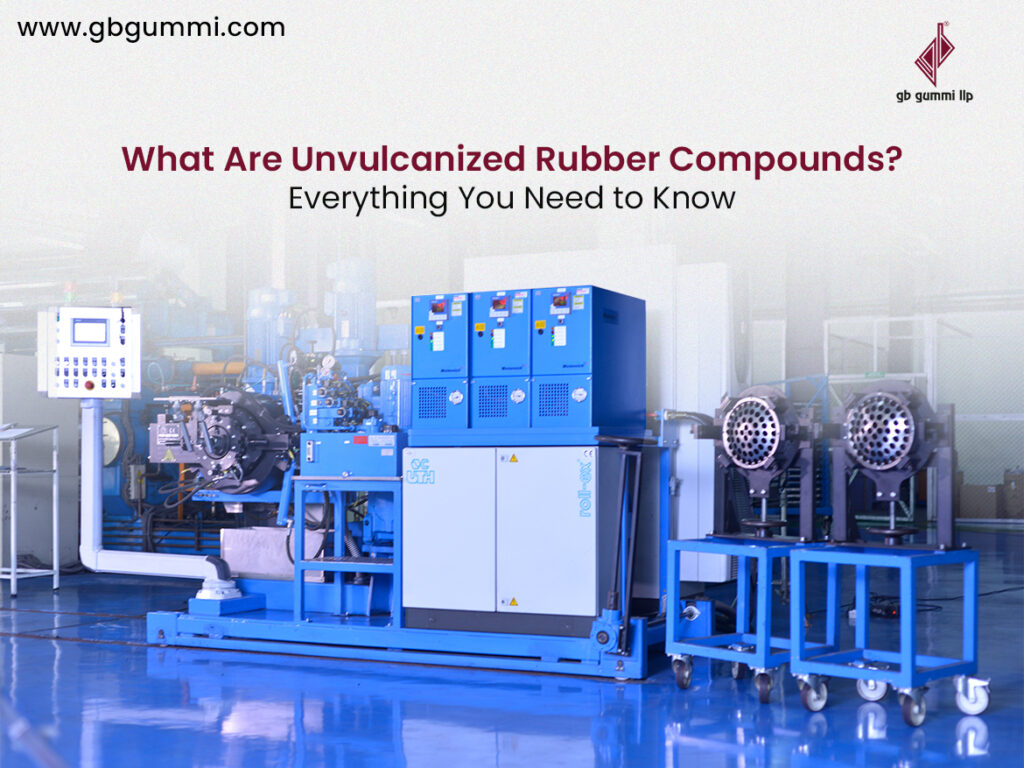Unvulcanized rubber compounds play a crucial role in the rubber manufacturing industry.
These compounds serve as the base material for countless rubber products across multiple sectors. Before undergoing vulcanization, rubber remains soft, flexible, and sticky, making it ideal for various production processes. Manufacturers work with unvulcanized rubber compounds to create everything from automotive components to industrial seals and adhesives.
In this guide, we will explore the properties, applications, processing methods, advantages, and handling requirements of unvulcanized rubber compounds.
What is an Unvulcanized Rubber Compound?
Unvulcanized rubber is raw rubber that has not undergone the curing process known as vulcanization. In its natural state, rubber is soft and lacks the mechanical strength required for durability. It remains highly plastic and sticky, allowing it to be molded into different shapes before it hardens.
During the manufacturing process, unvulcanized rubber is mixed with fillers, softeners, and other ingredients to achieve specific characteristics. Once it is ready, the compound can then be vulcanized, improving its strength, elasticity, and resistance to wear and tear.
Key Properties of Unvulcanized Rubber Compounds
Unvulcanized rubber compounds possess unique properties that make them suitable for multiple applications. Some of the most significant characteristics include:
High Plasticity: The material is highly flexible and can be easily shaped or molded.
Tackiness: Due to its sticky nature, it adheres well to other rubber layers, making it useful in lamination and bonding processes.
Malleability: Unvulcanized rubber compounds are easily manipulated into different forms before being vulcanized.
Soft Texture: The rubber remains soft and pliable, allowing for effortless handling and processing.
Mixing Capability: These compounds can be blended with various additives to achieve desired properties.
Applications of Unvulcanized Rubber Compounds
Unvulcanized rubber compounds are widely used across multiple industries due to their adaptability and ease of processing. Some common applications include:
1. Automotive Industry
Unvulcanized rubber is used in tire manufacturing, gaskets, seals, and interior components. It helps ensure durability and flexibility before the final vulcanization process.
2. Industrial Products
Rubber sheets, conveyor belts, hoses, and tubing are often manufactured using unvulcanized rubber compounds before being cured for strength and resistance.
3. Footwear Manufacturing
Shoe soles and other footwear components benefit from unvulcanized rubber compounds because they allow for precise shaping before vulcanization.
4. Adhesives and Sealants
Due to its natural tackiness, unvulcanized rubber is an essential ingredient in many adhesive and sealant formulations.
Processing of Unvulcanized Rubber Compounds
The transition from unvulcanized to vulcanized rubber involves a series of essential steps. Each stage contributes to refining the material and improving its durability and performance.
Mixing: The process begins with blending raw rubber with fillers, softeners, and stabilizers. This step enhances the properties of the compound and prepares it for further processing.
Shaping: The mixed rubber compound is then shaped into the desired form using techniques such as extrusion, molding, or calendering. At this stage, the rubber remains soft and flexible.
Vulcanization: The final step involves curing the rubber with sulfur or other curative agents at high temperatures. This process forms cross-links between the polymer chains, enhancing the rubber’s strength, elasticity, and durability.
Advantages of Using Unvulcanized Rubber Compounds
There are several benefits to working with unvulcanized rubber compounds:
- Customization: Manufacturers can modify the formulation to achieve specific characteristics required for different applications.
- Cost-Effectiveness: Unvulcanized rubber is often more affordable than fully processed rubber, making it ideal for large-scale production.
- Versatility: The material is used in a wide range of industries, from automotive to consumer goods.
- Ease of Processing: Due to its soft and moldable nature, it is easier to handle and shape before vulcanization.
Storage and Handling Considerations
Proper storage and handling of unvulcanized rubber compounds are necessary to maintain their quality and usability. Here are some best practices:
- Temperature Control: Store the material in a cool, dry environment to prevent premature curing or degradation.
- Avoid Contaminants: Keep away from oils, solvents, and chemicals that can affect the rubber’s properties.
- Manage Shelf Life: Over time, unvulcanized rubber can lose its effectiveness. It is crucial to use it within the recommended period to avoid wastage.
GB Gummi LLP: A Trusted Partner for Rubber Compounds
With over 40 years of experience, GB Gummi LLP is a leading manufacturer and supplier of rubber compounds in India. We specialize in producing high-quality unvulcanized rubber compounds tailored to various industrial applications. Our state-of-the-art manufacturing facility and stringent quality control measures ensure that our clients receive the best products.
At GB Gummi LLP, we work closely with our clients to provide customized rubber solutions that meet their specific requirements. Whether you need raw rubber compounds for automotive, industrial, or consumer goods, we are committed to delivering reliable and high-performance materials.
For more details about our products and services, visit our website or get in touch with our expert team today.

